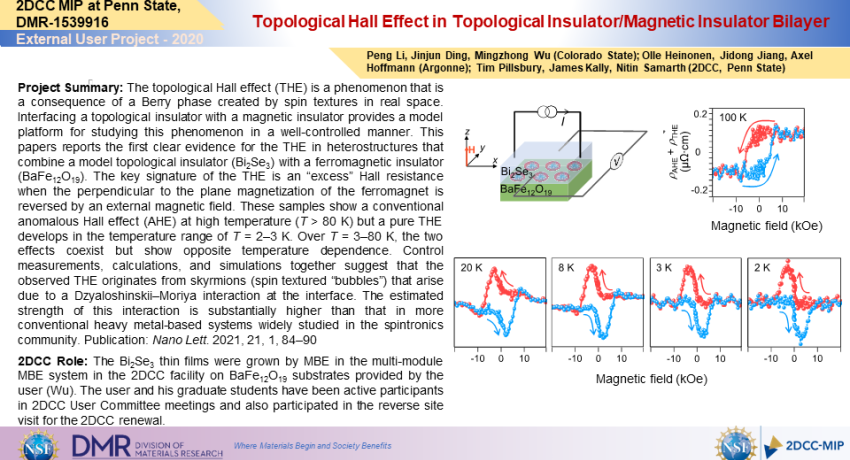Project Summary: The topological Hall effect (THE) is a phenomenon that is a consequence of a Berry phase created by spin textures in real space. Interfacing a topological insulator with a magnetic insulator provides a model platform for studying this phenomenon in a well-controlled manner. This papers reports the first clear evidence for the THE in heterostructures that combine a model topological insulator (Bi2Se3) with a ferromagnetic insulator (BaFe12O19). The key signature of the THE is an “excess” Hall resistance when the perpendicular to the plane magnetization of the ferromagnet is reversed by an external magnetic field. These samples show a conventional anomalous Hall effect (AHE) at high temperature (T > 80 K) but a pure THE develops in the temperature range of T = 2–3 K. Over T = 3–80 K, the two effects coexist but show opposite temperature dependence. Control measurements, calculations, and simulations together suggest that the observed THE originates from skyrmions (spin textured “bubbles”) that arise due to a Dzyaloshinskii–Moriya interaction at the interface. The estimated strength of this interaction is substantially higher than that in more conventional heavy metal-based systems widely studied in the spintronics community. Publication: Nano Lett. 2021, 21, 1, 84–90
2DCC Role: The Bi2Se3 thin films were grown by MBE in the multi-module MBE system in the 2DCC facility on BaFe12O19 substrates provided by the user (Wu). The user and his graduate students have been active participants in 2DCC User Committee meetings and also participated in the reverse site visit for the 2DCC renewal.
What Has Been Achieved: The experiment provides evidence for a topological Hall effect created by skyrmions and the Dzyaloshinskii–Moriya interaction at the interface between a topological insulator (Bi2Se3) and an insulating ferromagnet (BaFe12O19).
Importance of the Achievement: This study identified a model system wherein the topological Hall effect and skyrmions, phenomena of fundamental interest in condensed matter physics, can be systematically studied in an interfacial topological quantum material with no obvious artifacts.
Unique Feature(s) of the MIP that Enabled this Achievement: This project relied on 2DCC-MIP’s development of well-controlled MBE growth of good quality, wafer-scale epitaxial Bi2Se3 thin films on a ferromagnetic insulator.
Publication: Peng Li, Jinjun Ding, Steven S.-L. Zhang, James Kally, Timothy Pillsbury, Olle G. Heinonen, Gaurab Rimal, Chong Bi, August DeMann, Stuart B. Field, Weigang Wang, Jinke Tang, Jidong Samuel Jiang, Axel Hoffmann, Nitin Samarth, and Mingzhong Wu*
, Nano Lett. 21, 1, 84–90 (2021). DOI: 10.1021/acs.nanolett.0c03195
This work was supported by the U.S. Department of Energy, Office of Science, Basic Energy Sciences (DE-SC0018994). The fabrication and characterization of the samples were supported by the U.S. National Science Foundation (EFMA-1641989; ECCS-1915849). Instrumentation supported by the National Science Foundation MRI program (DMR-1727044) was used for this work. Work at Argonne National Laboratory was supported by the U.S. Department of Energy, Office of Science, Basic Energy Sciences, Division of Materials Sciences and Engineering. Work at CWRU was supported by the College of Arts and Sciences at CWRU. Work at PSU was supported by the Penn State Two-Dimensional Crystal Consortium-Materials Innovation Platform (2DCC-MIP) under the U.S. National Science Foundation Grant DMR-1539916. Work at UW was supported by the U.S. National Science Foundation (DMR-1710512) and the U.S. Department of Energy, Office of Science, Basic Energy Sciences (DE-SC0020074). Work at UA is supported by the U.S. National Science Foundation (ECCS- 1554011).
